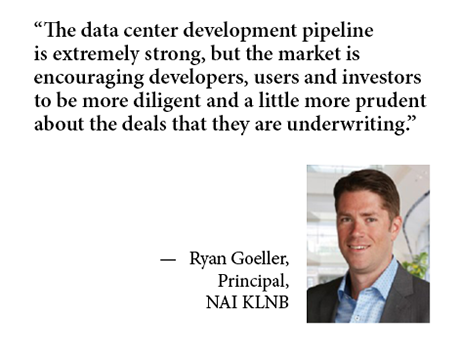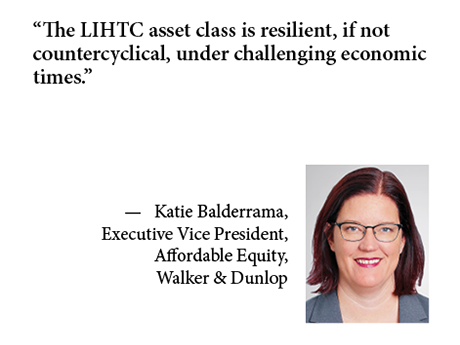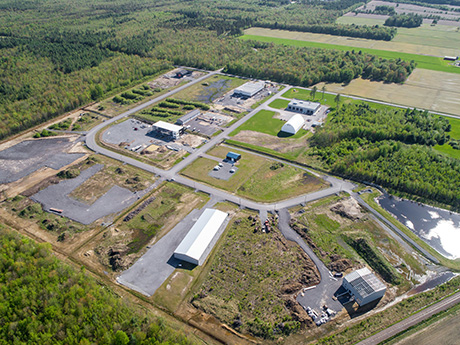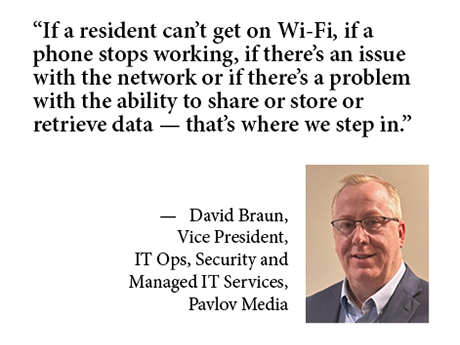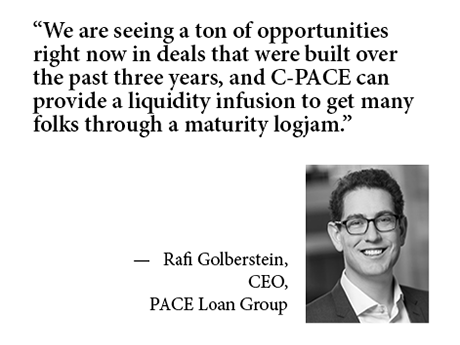The data center market remains a powerhouse of growth and demand in the commercial real estate world. REBusinessOnline sat down with Ryan Goeller, a principal at NAI KLNB commercial real estate services in Virginia, to discuss the various factors impacting this dynamic asset class. REBusinessOnline: Briefly, a data center is a dedicated building housing computer servers and storage systems, constantly processing and managing data for various applications. What is the current state of the data center market? Goeller: Extremely active, with very high demand. Development pipelines are at full power and are strained in certain markets. Leasing demand is through the roof. REBusinessOnline: What types of tenants use these data centers, and what are their space needs? Goeller: The majority of the time, the need for space is so insatiable that entire buildings are leased to single users, especially when it comes to large hyperscale computing projects. However, there are still colocation providers housing smaller tenants in certain buildings. A lot of the activity happening in Northern Virginia is hyperscale activity. These are large tech companies coming in and building 2-million-square-foot campuses that they’re fully occupying themselves. In these instances, the tenants aren’t likely to move once they occupy a space; …
Content Partner
Affordable HousingContent PartnerDevelopmentFeaturesLoansMidwestMultifamilyNortheastSoutheastTexasWalker & DunlopWestern
LIHTC Program Offers Lifeline to Struggling Multifamily Developers
It’s a tough time for much of multifamily development, but the Low-Income Housing Tax Credit (LIHTC) program offers incentives that make much-needed affordable housing comparatively easier to achieve under the current economic conditions. Building is expensive and financing is tight in the current multifamily market. However, as it has for the last 30 years, the LIHTC program provides solutions that increase the ease of creating and sustaining affordable housing, even when the overall multifamily market faces challenges. The program not only promotes the construction and acquisition of housing but also enforces conditions that help maintain the stability and preservation of affordable properties. The program is also needed to address the demand for affordable housing. The National Low Income Housing Coalition estimates that extremely low-income households represent 25 percent of the nation’s 44.1 million renters and reports a shortage of 7.3 million affordable and available rental homes. Historical Financial Resilience “The LIHTC asset class is resilient, if not countercyclical, under challenging economic times,” says Katie Balderrama, executive vice president of affordable equity at Walker & Dunlop. The firm typically sees a foreclosure rate of under 1 percent on properties supported by LIHTC. “Overall, our affordable housing assets tend to perform fairly …
AcquisitionsContent PartnerDevelopmentFeaturesIndustrialLee & AssociatesLoansMidwestMultifamilyNortheastOfficeRetailSoutheastTexasWestern
Property Owners Recalibrate Expectations Following Financing Challenge, Shifting Vacancy Rates
High costs, modulating occupancies and a lack of financing options reshaped the industrial, office, retail and multifamily sectors in the fourth quarter of 2023, signaling the determining factors for 2024, according to Lee & Associates’ 2023 Q4 North America Market Report. The industrial sector saw stabilizing tenant demand — the number of new buildings delivered increased in the fourth quarter, while new construction starts slowed. Meanwhile, the office sector’s struggles deepened as more than half of the office leases signed pre-2020 approach their expiration by 2026. With low-rate loans maturing into a high-rate environment, the factors troubling the office sector seem insurmountable in this decade. In the retail market, low vacancies did not lead to booming construction in that sector in the last quarter of 2023 — financing costs plus land and labor costs have hampered new development in spite of high demand. Finally, the health of multifamily markets is tied closely to geography. Sun Belt multifamily properties and their Midwest and Northeastern market counterparts are seeing reversals from the multifamily trends of 2021: formerly fast-growing Sun Belt markets are experiencing slowed rent growth or rent decline, while rent growth for slower-growing, major North and Midwestern metros has grown steadily. Lee & Associates …
AcquisitionsContent PartnerFeaturesLoansMidwestMultifamilyNAINortheastOfficeRetailSoutheastTexasWestern
Previous Year’s Challenges Shape 2024 Outlook for Cap Rates, Investment Activity, Distressed Properties
If NAI Global president and CEO Jay Olshonsky had to use one word to sum up the 2023 commercial real estate market, it would be “inactive.” The interest rate-fueled bid-ask spread stifled investment sales of all property types, and in the office sector especially, tenants avoided making any space decisions if they didn’t have to. One month into 2024, not much has changed. From an investment sales perspective, Olshonsky still sees properties offered at capitalization rates between 4 and 5 percent while interest rates are 6 percent or higher, which is prolonging the disconnect between buyers and sellers. Meanwhile, robust job creation well beyond today’s levels is needed to create the leasing demand that will reverse the office sector’s troubles in the new era of hybrid work. But that’s not likely to happen in 2024 as the tech sector, in particular, continues to lay off workers. “I’ve been in the real estate business a long time, and this is a cycle unlike most others,” says Olshonsky. “The biggest problem we have right now is mainly record-high office vacancy just about everywhere — certainly in the large cities — which we’ve never really seen before. On the investment side, lenders cannot …
With high operating costs eroding profitability at many urban stores, major retailers are concentrating development and store renovations in suburban locations with layouts geared to the latest consumer preferences. As more retailers follow suit, early adopters provide object lessons in best practices to better serve an evolving customer base and reveal pitfalls to avoid along the way. “Retailers are more sensitive to the pressures of high costs and loss prevention in urban markets, and as a result, they are backing off in those areas,” says Cornelius Brown, a principal and regional manager in the Philadelphia office of Bohler. “Retailers looking to grow, in our experience, are shifting to the suburbs and using retail program methods to cut costs.” Bohler is a land development design and consulting firm that helps developers move their projects forward quickly. Recently, those clients have been keen to avoid risk in both site selection and design features, Brown says. Streamlining Retail Development Retail programs allow developers to use pre-existing retail layout prototypes to determine optimal site arrangements. This approach uses checklists to assign one of several pre-made layouts to a development based on factors such as road location, grading and elevation, parking needs, drive-through layout, loading …
The multifamily industry has its hands full: finance in adverse economic conditions, rapidly rising operation costs, as well as the challenge of attracting and keeping quality tenants as the biggest jump in new inventory creates more competition than the industry has seen in decades. Technology is an enabling and defining tool in the midst of these challenges. Tenants often expect services like internet access, telephone, television and Wi-Fi hotspots throughout a complex. Multifamily property staff need data access, speciality software, as well as the ability to schedule prospective resident visits, remote viewing, maintenance and more. Relatively few multifamily operations have the scope, scale and economics for an IT staff that can handle the support and repair requirements necessary to install systems, keep them working, protect data and networks while assisting tenant and staff users, particulary 24 hours a day, 7 days a week. Managed IT services are third-party companies that remotely provide the IT expertise and the help a company requires. “If a resident can’t get on Wi-Fi, if a phone stops working, if there’s an issue with the network or if there’s a problem with the ability to share or store or retrieve data — that’s where we step …
Commercial property conversions can offer significant advantages over conventional ground-up real estate developments. Conversions can provide a head start on construction with established entitlements, existing structures, in-place utilities and entry to choice locations in otherwise built-out submarkets. Consider the Universal Buildings, Post Brothers’ conversion of two 1960s-era office buildings into more than 600 residential units and ground-floor retail just north of the District of Columbia’s Dupont Circle. The 15-story complex will feature a two-level, glass-walled fitness and recovery center with more than 10,000 square feet of training zones, equipment and classrooms. The developer is housing the fitness center and other amenities in a new atrium that replaces the upper levels of structured parking originally built within one of the former office buildings. “The location is incredible — there is probably no greater location in any major city in the country for conversion,” says Josh Guelbart, Post Brothers’ Co-Chief Operating Officer. “Having the entire block means we have light, air and hilltop views of Kalorama, Adams Morgan and Dupont Circle, three of the finest residential neighborhoods in the District. There isn’t room for new buildings of scale in those neighborhoods, and that really made this existing, large building attractive to us.” …
The term “adaptive reuse” in real estate circles typically conjures images of repurposing old, obsolete commercial buildings. Meanwhile, academic buildings, administrative offices and other properties on college campuses rarely come to mind. But NAI has noted a growing need among higher learning institutions with vacant or underused assets, particularly as a result of growing online learning options, says Larry Gautier, senior vice president of NAI Miami | Fort Lauderdale. As a result, the brokerage is focused on finding solutions for schools. “NAI hasn’t historically been involved with higher institutions of learning — we’ve typically focused on conventional real estate transactions,” Gautier acknowledges. “But a few years ago, when students weren’t going in to class, colleges and universities were facing a challenge: what do you do with facilities — that were built for thousands of students — in a remote-learning setting? For many schools, remote learning is here to stay.” Options include leasing buildings to commercial users or entering a joint venture with, for example, an aerospace or engineering company for educational programs, he adds. Colleges that suddenly have vast unused parking lots could also enter into long-term leases with multifamily, office or mixed-use developers. “Our position is to help these schools create …
The spike in interest rates and the consequent disruption throughout real estate capital markets over the last 18 months is generating newfound interest in commercial property assessed clean energy (C-PACE) financing. The program, which emerged more than a decade ago, pays for building upgrades to improve energy and water efficiency as well as seismic resilience in new construction and rehabs. In cases where cost overruns, stabilization delays and declining values threaten the ability to refinance construction loans, developers are tapping C-PACE retroactively for a much-needed slug of so-called “rescue capital,” says Rafi Golberstein, CEO of the PACE Loan Group, a direct lender of C-PACE based in Minneapolis, Minn. Typically, developers are using the proceeds to pay down debt and fund reserves to secure loan extensions or modifications. “We are seeing a ton of opportunities right now in deals that were built over the past three years, and C-PACE can provide a liquidity infusion to get many folks through a maturity logjam,” he declares. “When confronted with other options, they’re going to prefer C-PACE all day long.” Cost-Effective Debt Indeed, the cost of those other options, such as mezzanine financing or preferred equity, can be upwards of 500 basis points higher …
AcquisitionsContent PartnerFeaturesLee & AssociatesMidwestMultifamilyNortheastOfficeRetailSoutheastTexasWestern
Is a Rebound in the Cards for Investment Sales Anytime Soon?
Would-be commercial real estate investors and sellers for the last several months have been waiting for a sign that the Federal Reserve has tamed inflation, therefore giving the central bank reason to officially end its tightening program. October’s better-than-expected consumer price index increase of 3.2 percent — versus the 3.3 percent consensus — may have delivered that signal. The futures markets immediately reduced the probability of a Fed interest rate hike in December to zero, with many capital markets analysts suggesting that it would begin to cut rates midway through 2024. But just an end to rate hikes could fuel investment sales activity, says Jeff Rinkov, CEO of Lee & Associates Commercial Real Estate Services. “Once investors see some positive sentiment from the Fed, I think they’ll start to get interested in deploying what we believe is an enormous amount of capital that has been waiting on the sidelines,” he explains. “I also think that’s when investors will be met by more accommodating sellers. At the moment, price discovery continues to be very challenging and is driving a sluggish transaction environment.” Crashing Sales Indeed, investment sales volume through three quarters of 2023 totaled $276.3 billion, a year-over-year decline of 55 …


